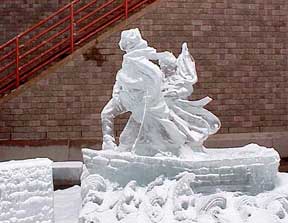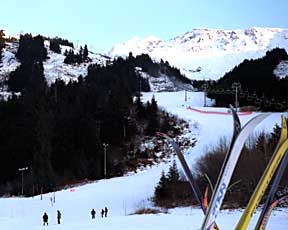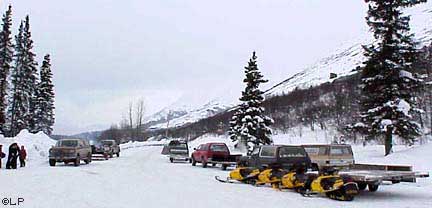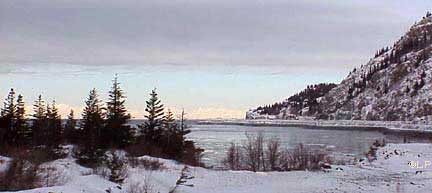Winter in Alaska
In the summer, Beluga Point on the Seward
Highway a few miles southeast of Anchorage is a popular
spot to stop, enjoy the view and, perhaps, catch a glimpse of
a pod of beluga whales. The winter views are dramatic, too,
though often more somber as on this overcast day. The whiteness
on the horizon is not low-lying clouds but distant peaks of
the Alaska Range, rising 11,000 to 13,000 feet above sea level.
Mount McKinley, at 20,320 feet the tallest mountain in North
America, is part of this range.
 Anchorage gets much less snow in the winter than do a few cities in the Lower 48 such as Buffalo, N.Y. But the snow starts falling in early to mid-October and it stays on the ground till April. A snowfall on April 25, 2008, just as Anchorage residents thought they'd seen the last of winter, put a record for the day of 15.5 inches of snow on the ground. Anchorage gets much less snow in the winter than do a few cities in the Lower 48 such as Buffalo, N.Y. But the snow starts falling in early to mid-October and it stays on the ground till April. A snowfall on April 25, 2008, just as Anchorage residents thought they'd seen the last of winter, put a record for the day of 15.5 inches of snow on the ground.
If you want snow, Valdez, on the southcentral coast, is the
place to go. Known as one of the snowiest places in Alaska,
it received four feet of snow in a single December weekend in
1999 and had received 136 inches by December 22nd, the official
first day of winter. In recent years, extreme skiing competitions
have been held in the nearby mountains.
Winter temperatures in Anchorage average in the teens, and it gets colder as you go north. Forty-below (Fahrenheit) isn't unusual in Fairbanks, and it's so cold on Alaska's North Slope oil fields that vehicles sitting outdoors may not be turned off for months at a time. A former mayor of Fairbanks tells of seeing a tire fall off a truck there and shatter on hitting the street when it was 60 below.
A couple of winter phenomena that are not encountered in many other places are ice fog and black ice. Ice fog is composed of ice crystals suspended in the air, which sometimes happens when it's 40 below, and it's just as challenging to drive in as any other kind of fog. Black ice on roads is feared by drivers because they don't become aware of it until they're skidding on it.
 Another,
dramatic winter phenomenon is the building up of hoarfrost on
trees. Because the Anchorage area often has several windless
days in a row, a thick layer of hoarfrost sometimes builds up
on exposed surfaces, turning them a frosty white. Another,
dramatic winter phenomenon is the building up of hoarfrost on
trees. Because the Anchorage area often has several windless
days in a row, a thick layer of hoarfrost sometimes builds up
on exposed surfaces, turning them a frosty white.
A look at temperatures in various Alaska locations on Dec. 21, 1999, the day before the winter solstice, provides an idea of the range of winter weather in the state. The high temperature was 50 (Fahrenheit) in Sitka, which is in Southeast Alaska, and the low was -41 in Deering, a village on the shores of Kotzebue Sound in Northwest Alaska. (The two communities are about 1,200 miles apart, as the raven flies.) The high in Fairbanks was 12; in Barrow, on the North Slope, it was -8; and at Dutch Harbor, in the Aleutians, it was 27 and windy. The high in Anchorage was 41, well above the normal high for that day of 22, and it had 5 hours and 28 minutes of daylight on this, the day before the shortest day of the year. Barrow, in the middle of its months-long night, had no daylight at all.
Popular winter activities in Alaska include downhill and cross-country
skiing (the photo above is of one of the ski runs at Alyeska
in Girdwood, about an hour's drive from Anchorage), skijoring
(skiers are pulled by one or two dogs), snowmachining, dog-sled
racing and snowshoeing. Alyeska, about 35 miles southeast of
Anchorage (it's included in the Anchorage municipality) has
slopes that attract downhill skiers from Europe as well as from
the Lower 48. Ice sculpting competitions are held in Fairbanks
and in Anchorage. The above sculpture of George Washington crossing
the Delaware is from a contest in Anchorage.

Snowmachines
await their riders outside Summit Lodge, a popular stop on the
Seward Highway.
|

